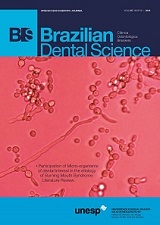Strain Gauge analysis of non-axial loads in three-element implant-supported prostheses
DOI:
https://doi.org/10.14295/bds.2013.v16i2.866Abstract
This study evaluated “in vitro”, the microstrain around three external hexagon implants linearly placed after static loadings on non-axial points of Co-Cr superstructures. The implants were inserted into a polyurethane block and their microunit prosthetic abutments were screwed with torque of 20 Ncm. Four strain gauges were linked to the block around the implants. Onto the abutments, Co-Cr superstructures (n = 5) were screwed with torque of 10 Ncm. The static vertical loads of 30 kg were applied for 10 s during 3 repetitions in four non-axial points located perpendicularly to the long axis (A and B) and another two points at the extremity of the superstructure (A` and B`). The data were recorded with the aid of a conditioner of electrical signals and the Strain-Smart software. The results obtained were submitted to Analysis of Variance (ANOVA). It could be concluded that there were no significant differences in the effects of the applications of non-axial loads of this present study (p = 0.6464). Also, there were no differences between the displacement means, 3 mm for A and B; 5 mm for A’ and B’ (p = 0.8731).
Keywords
Biomechanics, Dental implant, Dental prosthesis.
Downloads
Downloads
Published
How to Cite
Issue
Section
License
Brazilian Dental Science uses the Creative Commons (CC-BY 4.0) license, thus preserving the integrity of articles in an open access environment. The journal allows the author to retain publishing rights without restrictions.
=================




























